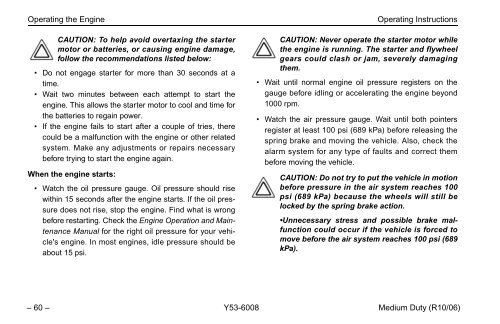Peterbilt Medium Duty Trucks Operator's Manual after 1-07
Peterbilt Medium Duty Trucks Operator's Manual after 1-07
Peterbilt Medium Duty Trucks Operator's Manual after 1-07
You also want an ePaper? Increase the reach of your titles
YUMPU automatically turns print PDFs into web optimized ePapers that Google loves.
Operating the Engine<br />
CAUTION: To help avoid overtaxing the starter<br />
motor or batteries, or causing engine damage,<br />
follow the recommendations listed below:<br />
• Do not engage starter for more than 30 seconds at a<br />
time.<br />
• Wait two minutes between each attempt to start the<br />
engine. This allows the starter motor to cool and time for<br />
the batteries to regain power.<br />
• If the engine fails to start <strong>after</strong> a couple of tries, there<br />
could be a malfunction with the engine or other related<br />
system. Make any adjustments or repairs necessary<br />
before trying to start the engine again.<br />
When the engine starts:<br />
• Watch the oil pressure gauge. Oil pressure should rise<br />
within 15 seconds <strong>after</strong> the engine starts. If the oil pressure<br />
does not rise, stop the engine. Find what is wrong<br />
before restarting. Check the Engine Operation and Maintenance<br />
<strong>Manual</strong> for the right oil pressure for your vehicle's<br />
engine. In most engines, idle pressure should be<br />
about 15 psi.<br />
Operating Instructions<br />
CAUTION: Never operate the starter motor while<br />
the engine is running. The starter and flywheel<br />
gears could clash or jam, severely damaging<br />
them.<br />
• Wait until normal engine oil pressure registers on the<br />
gauge before idling or accelerating the engine beyond<br />
1000 rpm.<br />
• Watch the air pressure gauge. Wait until both pointers<br />
register at least 100 psi (689 kPa) before releasing the<br />
spring brake and moving the vehicle. Also, check the<br />
alarm system for any type of faults and correct them<br />
before moving the vehicle.<br />
CAUTION: Do not try to put the vehicle in motion<br />
before pressure in the air system reaches 100<br />
psi (689 kPa) because the wheels will still be<br />
locked by the spring brake action.<br />
•Unnecessary stress and possible brake malfunction<br />
could occur if the vehicle is forced to<br />
move before the air system reaches 100 psi (689<br />
kPa).<br />
– 60 – Y53-6008 <strong>Medium</strong> <strong>Duty</strong> (R10/06)
















